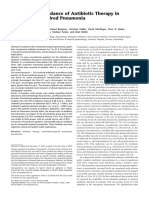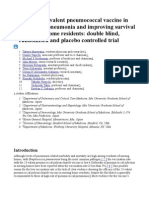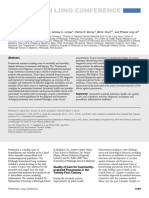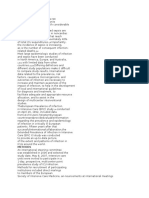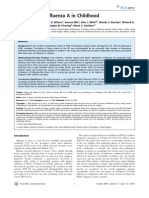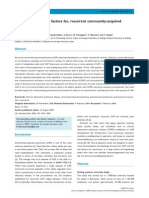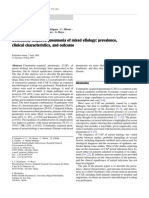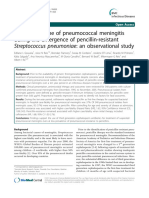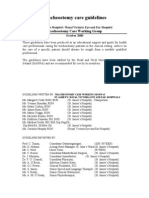Pneumonia
Pneumonia
Uploaded by
Sausan Hana MaharaniCopyright:
Available Formats
Pneumonia
Pneumonia
Uploaded by
Sausan Hana MaharaniCopyright
Available Formats
Share this document
Did you find this document useful?
Is this content inappropriate?
Copyright:
Available Formats
Pneumonia
Pneumonia
Uploaded by
Sausan Hana MaharaniCopyright:
Available Formats
520
Impact of Penicillin Susceptibility on Medical Outcomes for Adult Patients
with Bacteremic Pneumococcal Pneumonia
Joshua P. Metlay,1 Jo Hofmann,3,a Martin S. Cetron,3
Michael J. Fine,2 Monica M. Farley,4 Cynthia Whitney,3
and Robert F. Breiman3
From the 1Veterans Affairs Medical Center and University
of Pennsylvania School of Medicine, Philadelphia, and 2Center
for Research on Health Care and Division of General Internal
Medicine, University of Pittsburgh, Veterans Affairs Health Care
System, Pittsburgh, Pennsylvania; 3Childhood and Respiratory Disease
Branch, National Center for Infectious Disease, Centers for Disease
Control and Prevention, and 4Division of Infectious Diseases,
Department of Medicine, Emory University School of Medicine
and Veterans Affairs Medical Center, Atlanta, Georgia
Streptococcus pneumoniae is the most commonly identified
pathogen in patients with community-acquired pneumonia and
is responsible for substantial mortality and morbidity. Recent
studies have documented an alarming increase in the rate of
antimicrobial drug resistance among isolates of S. pneumoniae
from patients with community-acquired pneumonia [14]. In 1
surveillance program involving 27 United States medical centers
in 1997, the overall level of penicillin nonsusceptibility was
43.8%, with 27.8% of isolates demonstrating intermediate susceptibility to penicillin (MIC, 0.11 mg/mL) and 16% resistant
to penicillin (MIC, >2 mg/mL) [5].
Although most studies have not demonstrated an adverse
impact of drug resistance on medical outcomes for patients with
pneumococcal pneumonia [68], many clinicians expect that
increased morbidity and mortality will become apparent as the
Received 13 July 1999; revised 9 November 1999; electronically published
9 March 2000.
Financial support: J. P. M. is supported by a Career Development Award
from the Department of Veterans Affairs and a Measey Foundation Fellowship. The active surveillance was funded by the Centers for Disease
Control and Prevention.
a
Current affiliation: Snohomish Health District, Everett, Washington.
Reprints or correspondence: Dr. Joshua P. Metlay, Center for Clinical
Epidemiology and Biostatistics, University of Pennsylvania, 712 Blockley
Hall, 423 Guardian Drive, Philadelphia, PA 19104 (jmetlay@cceb.med
.upenn.edu).
Clinical Infectious Diseases 2000; 30:520528
q 2000 by the Infectious Diseases Society of America. All rights reserved.
1058-4838/2000/3003-0019$03.00
proportion of resistant strains and their MICs continue to increase. Guidelines and recommendations for empirical therapy
for patients with community-acquired pneumonia have already
been modified to account for these resistance patterns [9]. The
absence of a demonstrated correlation between pneumococcal
drug resistance and adverse medical outcomes may reflect the
predominance of isolates with only intermediate levels of penicillin resistance in prior studies. In addition, few studies of
outcome have included patients whose isolates are resistant to
the antimicrobial drugs that were used in their therapy (discordant therapy).
Recent work has highlighted the degree to which in vitro
susceptibility results do not directly correlate with the predicted
in vivo efficacy of antimicrobial drugs [10]. Another limitation
of most studies has been the reliance on a single clinical outcomedeathto measure antimicrobial efficacy. However,
mortality may be a relatively insensitive measure of antibiotic
efficacy, given the historical finding that the rate of mortality
associated with pneumococcal pneumonia during the first 72 h
was relatively unaffected by the introduction of antimicrobial
therapy [11]. Recent work has validated the use of additional
in-hospital and postdischarge measures to evaluate other medical outcomes for patients with community-acquired pneumonia [1214].
The aim of this study was to compare medical outcomes,
including in-hospital mortality, medical complication rates, and
times to clinical stability, between patients with communityacquired pneumonia due to penicillin-susceptible strains of S.
Downloaded from http://cid.oxfordjournals.org/ by guest on September 10, 2015
The impact of penicillin susceptibility on medical outcomes for adult patients with bacteremic pneumococcal pneumonia was evaluated in a retrospective cohort study conducted
during population-based surveillance for invasive pneumococcal disease in the greater Atlanta
region during 1994. Of the 192 study patients, 44 (23%) were infected with pneumococcal
strains that demonstrated some degree of penicillin nonsusceptibility. Compared with patients
infected with penicillin-susceptible pneumococcal strains, patients whose isolates were nonsusceptible had a significantly greater risk of in-hospital death due to pneumonia (relative
risk [RR], 2.1; 95% confidence interval [CI], 14.3) and suppurative complications of infection
(RR, 4.5; 95% CI, 119.3), although only risk of suppurative complications remained statistically significant after adjustment for baseline differences in severity of illness. Among adults
with bacteremic pneumococcal pneumonia, infection with penicillin-nonsusceptible pneumococci is associated with an increased risk of adverse outcome.
CID 2000;30 (March)
Susceptibility to Penicillin and Outcome of Pneumonia
pneumoniae and those infected with penicillin-nonsusceptible
strains. A secondary aim was to measure the frequency of discordant antimicrobial therapy among patients with penicillinnonsusceptible pneumococcal pneumonia.
Methods
diographic values [19]. This index generates a score that can be
used to classify patients into 5 risk classes, with 30-day observed
mortality ranging from 0.1% for class I (lowest risk) to 27% for
class V (highest risk).
Four variables from the original PSI were not available for this
data analysis because they were not included during the original
chart abstraction. These variablespresence of cerebrovascular
disease, altered mental status, and blood glucose and blood urea
nitrogen values at the time of admissionwere omitted in the calculation, resulting in a modified PSI for this study. Stratification
of patients into the original 5 risk classes with use of this modified
PSI resulted in significant discrimination of disease severity, with
observed in-hospital mortality rates of 3.7%, 4.4%, 9.4%, 22.9%,
and 38.9% for patients in risk classes IV, respectively (P = .001
for test of trend).
Assessment of medical outcomes was based on medical chart
review. A standardized data collection form was used to abstract
medical-record data on initial and subsequent antimicrobial chemotherapy, daily vital sign data, in-hospital complications and
morbid events, in-hospital deaths, and time to hospital discharge.
For daily vital signs, the highest temperature, heart rate, and respiratory rate and the lowest systolic blood pressure were abstracted
from the medical chart for each of the first 7 days of hospitalization.
In-hospital complications were recorded during the first 7 days of
hospitalization and included admission to an intensive care unit,
mechanical ventilation, and receipt of intravenous pressor agents
(dopamine, dobutamine, norepinephrine bitartrate, and/or epinephrine). Additional suppurative complications of pneumococcal
illness included empyema, lung abscess, and osteomyelitis.
Antimicrobial susceptibility testing was performed on all isolates
by the broth-dilution method at the Centers for Disease Control
and Prevention [20]. The susceptibility breakpoints for each drug
were defined according to 1994 National Committee for Clinical
Laboratory Standards (NCCLS) guidelines [21, 22]. The NCCLS
has defined 3 separate categories of antimicrobial susceptibility:
susceptible, intermediate (formerly called low-level resistance, corresponding to MICs of 0.11 mg/mL of penicillin), and resistant
(formerly called high-level resistance, corresponding to MICs >2
mg/mL of penicillin) [21]. For the purposes of this article, penicillinintermediate or -resistant isolates are referred to as penicillinnonsusceptible.
Analysis.
For all analyses, patients pneumococcal isolates
were categorized as penicillin-susceptible or -nonsusceptible, as described above. Baseline demographic, clinical, and laboratory variables were compared with x2, Fishers exact, or Cochran-MantelHaenszel trend statistics, where appropriate, with use of 2-sided
tests and a P value !.05 to indicate statistical significance [23].
In-hospital mortality was determined for all study patients on
the basis of the medical-records review. Pneumonia-related deaths
were defined as those in which pneumonia was the major contributing cause according to the medical records; in those cases in which
the cause was not clearly documented, death within 7 days following admission was also considered pneumonia-related. Deaths that
did not appear to be pneumonia-related, as determined at the time
of medical-record review, and occurred 17 days after admission
were coded as non-pneumonia-related deaths. This mortality classification scheme is consistent with findings from prior studies on
mortality associated with community-acquired pneumonia [24].
Downloaded from http://cid.oxfordjournals.org/ by guest on September 10, 2015
Patients. Patients for this study were enrolled as part of a
population-based surveillance of invasive infections due to S. pneumoniae within the metropolitan Atlanta region from January
through October 1994. Details of this surveillance have been reported elsewhere [2, 15]. In brief, microbiology laboratories of 32
hospitals and 1 major reference laboratory in the 8-county metropolitan Atlanta area contributed pneumococcal isolates from
normally sterile sites, including blood, CSF, and pleural fluid. Patients who had isolates recovered from these sites were considered
to have invasive pneumococcal diseases. Laboratories provided
demographic and limited clinical data on the patients.
Patients were excluded from the study if they resided outside the
surveillance area, their place of residence was unknown, or the
source of their isolate was unknown. This exclusion occurred before
the collection of any medical-record data. Medical records were
requested and subsequently abstracted for all hospitalized patients
with invasive pneumococcal disease. For those patients whose medical records were not available, limited data could be obtained from
the initial surveillance case report form, which allowed these excluded patients to be compared with the patients whose medical
records were available.
We restricted analyses to adult patients (aged >18 years) with
invasive pneumococcal disease whose medical records were available for review and who met criteria for diagnosis of bacteremic
pneumococcal pneumonia. These criteria included findings on admission chest radiography consistent with pneumonia, including
infiltrate, consolidation, or effusion. Patients whose CSF yielded
S. pneumoniae were excluded. We restricted the analyses to patients
aged >18 years because adult and pediatric pneumonia are etiologically distinct entities [16] associated with distinct management
strategies (involving differences in hospitalization rates, for instance) and clinical outcomes (including differences in mortality
rates). In addition, the pneumonia-specific severity models used for
the analyses were developed and validated in adult populations
only [1719]. Finally, we excluded patients who did not have pneumonia diagnosed within 48 h of hospital admission. For this exclusion, we used the date of first administration of an antimicrobial
drug as the date of diagnosis. Patients with pneumonia diagnosed
after 48 h of hospitalization are more likely to have nosocomial
pneumonia [14].
Data collection. Baseline information on sociodemographic
characteristics, initial severity of pneumonia, comorbid conditions,
vital signs, laboratory results, and chest radiographic findings on
admission were collected for all study subjects by use of a structured
medical chart abstraction tool. Pneumonia severity was assessed
by means of the Pneumonia Severity Index (PSI), a well-validated
disease-severity classification based on age, sex, nursing home residence, 5 comorbid illnesses (neoplastic disease, liver disease, congestive heart failure, cerebrovascular disease, and renal disease),
vital signs on admission, mental status, and 7 laboratory and ra-
521
522
Metlay et al.
Results
Patients characteristics. During the surveillance period of
this study (1 January 1994 through 31 October 1994), 527 patients with cases of invasive pneumococcal disease were identified in the source population of metropolitan Atlanta. Pneumococcal isolates for susceptibility testing and inpatient
medical records for review were available for 296 patients
(56%). Compared with the adult hospitalized patients without
available medical records, the patients with available records
were not significantly different in terms of sex, age, or overall
mortality (data not shown). A total of 192 of the case patients
with available medical records (65%) met study-eligibility criteria and thus are the study group for this study. The noneligible
patients with medical records available for review and the eligible patients were similar with respect to sex and race/ethnicity. However, since an age of !18 years was an exclusion
criterion, eligible patients had markedly increased frequency of
comorbid illnesses associated with advanced age, including cardiovascular disease (20% vs. 8%, P = .013).
The mean age of the study group was 53 years (range, 2193
years); 47% were women; 47% were white, non-Hispanic; and
5% were admitted from nursing homes or chronic care facilities.
HIV infection was documented in 28% of patients, and chronic
pulmonary disease, including asthma and chronic obstructive
pulmonary disease, was documented in 27% of patients.
Of the 192 study patients, 44 (23%) had documented infection
with nonsusceptible pneumococci, 36 (19%) had intermediatesusceptible isolates, and 8 (4%) had resistant isolates. Compared
with patients infected with susceptible strains, patients with
nonsusceptible isolates were older (43% vs. 26% were >65 years;
P = .03), more likely to be white, non-Hispanic (63% vs. 42%;
P = .02), less likely to be uninsured (14% vs. 31%; P = .02), and
more likely to be admitted from a nursing home (11% vs. 3%,
P = .05). The frequency of comorbid conditions in the susceptible and nonsusceptible infection groups was similar, with the
exception of renal disease, which was less frequent in the susceptible-infection group (7% vs. 20%; P = .018), and alcohol/
drug abuse, which was more frequent in the susceptible group
(41% vs. 19%; P = .015; table 1).
Table 1. Demographic and clinical characteristics of patients with
bacteremic pneumococcal pneumonia.
a
No. (%) of patients infected with
Characteristic
Age >65 y
Female
White, non-Hispanic
Type of insurance
Medicare or private
Medicaid
None
Nursing home resident
Comorbid illness
c
Chronic lung disease
Coronary artery disease
Congestive heart failure
Renal disease
Hepatic disease
d
HIV infection
Active cancer
e
Alcohol or drug abuse
Pen-S pneumococci
(n = 148)
Pen-NS pneumococci
(n = 44)
39 (26)
72 (49)
61 (42)
19 (43)
18 (41)
27 (63)
.033
.366
.019
86
26
46
5
(58)
(18)
(31)
(3)
28
11
6
5
(64)
(25)
(14)
(11)
.512
.272
.022
.051
40
13
10
10
13
43
19
51
(27)
(9)
(7)
(7)
(9)
(29)
(13)
(41)
11
5
5
9
6
11
9
7
(25)
(11)
(11)
(20)
(14)
(25)
(20)
(19)
.771
.567
.341
.018
.403
.599
.209
.015
NOTE. Pen-NS, penicillin-nonsusceptible (MIC >0.1 mg/mL); Pen-S, penicillin-susceptible (MIC !0.1mg/mL).
a
Patients for whom data were missing represented !5% of the study group
for each variable, except alcohol/drug abuse (16%), and were excluded from
denominator of relevant analyses.
b
Based on x2 or Fishers exact test (when expected counts were !5 per cell).
c
Includes chronic obstructive pulmonary disease, asthma, and restrictive/interstitial lung disease.
d
HIV infection was documented in 28% of patients; those patients whose HIV
status was not documented were assumed to be HIV-negative.
e
Includes documented alcohol, cocaine, or injection drug abuse.
Downloaded from http://cid.oxfordjournals.org/ by guest on September 10, 2015
Pneumonia-related mortality rates and medical complication
rates were compared between patients with penicillin-susceptible
and penicillin-nonsusceptible pneumococcal isolates. Unadjusted
results were reported as RRs with 95% CIs. In additional analyses,
adjustments were made for severity of illness at baseline by stratification according to the 5 levels of pneumonia severity, determined
by means of the PSI. In these stratified analyses, the Mantel-Haenszel procedure was used to calculate common RRs, with adjustments
for pneumonia-severity risk group [23].
The time to resolution of individual vital sign abnormalities was
defined as the first day that the highest or lowest value for the vital
sign was within a predetermined normal range. For temperature,
the maximum normal value was 37.27C; for heart rate, the maximum normal value was 100 beats/min; for respiratory rate, the
maximum normal value was 24 breaths/min; and for systolic blood
pressure, the minimum normal value was 90 mm Hg. These cutoff
points have been previously validated as measures of stability for
patients recovering from community-acquired pneumonia. Validation was performed by demonstrating that among hospitalized
patients with pneumonia, once vital signs had normalized, clinical
deterioration requiring intensive care, coronary care, or telemetry
was extremely rare [12]. The time to individual vital sign stability
was calculated with the Kaplan-Meier product-limit method; logrank tests were used to compare times between patients with susceptible and nonsusceptible pneumococcal isolates [25, 26].
In these analyses, only patients with a documented unstable vital
sign during the first day of hospitalization were entered in each
separate vital sign analysis. The overall time to vital sign stability
was calculated on the basis of time to resolution of all 4 vital sign
abnormalities, including those for all patients with at least 1 vital
sign abnormality during the first day of hospitalization. All analyses were conducted with SAS for Windows (Release 6.12, SAS
Institute, Cary, NC).
Finally, a descriptive analysis was completed to examine the
concordance of initial empirical antibiotic therapy delivered within
the first 48 h of hospitalization. Concordant therapy was defined
as the receipt (during the first 48 h) of any antimicrobial agent that
belonged to an antimicrobial drug class to which the isolate demonstrated full in vitro susceptibility. Conversely, if all antimicrobial
drugs used to treat a patient during the first 48 h of hospitalization
were within drug classes to which the pneumococcal isolate demonstrated any level of antimicrobial nonsusceptibility, the patients
therapy was classified as discordant.
CID 2000;30 (March)
CID 2000;30 (March)
Susceptibility to Penicillin and Outcome of Pneumonia
All of the patients with nonsusceptible isolates and suppurative complications had documented empyemas, and 1 patient
had both an empyema and a lung abscess. Even after adjustment for differences in severity of illness at admission, patients
with nonsusceptible pneumococcal infections had a significantly
higher rate of suppurative complications than did patients with
susceptible pneumococcal infections (RR, 4.8; 95% CI, 1.2
18.8; table 3). In addition, adjustment of these analyses for
pneumococcal serotype did not change the association between
penicillin nonsusceptibility and increased risk of suppurative
complications (data not shown).
Among the subgroup of patients with documented HIV infection, the RR for pneumonia-related death was 11.7 (95%
CI, 1.3102.1) comparing patients infected with penicillin-nonsusceptible versus penicillin-susceptible S. pneumoniae. Among
patients without documented HIV infection, the RR for death
was only 1.5 (95% CI, .63.3). Similar associations were not
observed for the other measured clinical outcomes. The small
size of these subgroups did not permit further adjustment of
these data for differences in severity of illness at admission.
Time to clinical stability. For each vital sign, similar proportions of patients in each group were identified as unstable
during the first day of hospitalization. Among patients with a
temperature 137.27C during the first hospital day, the median
time to stability (temperature, <37.27C) was 4 days for patients
Table 2. Abnormal vital signs, abnormal laboratory values, and severity of illness
at admission for patients with bacteremic pneumococcal pneumonia.
a
No. (%) of patients infected with
Abnormality
Vital sign
Heart rate >125 beats/min
Respiratory rate >30 breaths/min
Temperature !357C or >407C
Systolic blood pressure !90 mm Hg
Laboratory value
Sodium !130 mmol/L
Creatinine >2 mg/dL
Hemoglobin !10 g/dL
c
Oxygen saturation !90%
pH !7.35
d
Severity-of-illness risk class
I
II
III
IV
IV
V
Pen-S pneumococci
(n = 148)
Pen-NS pneumococci
(n = 44)
59
50
6
8
(40)
(34)
(4)
(5)
19
15
4
1
(43)
(34)
(9)
(2)
.694
.992
.236
.687
24
24
19
45
12
(17)
(17)
(13)
(39)
(10)
3
10
10
12
3
(7)
(24)
(23)
(43)
(11)
.135
.301
.101
.718
1
e
.050
25
34
43
34
34
12
(17)
(23)
(29)
(23)
(23)
(8)
2
12
10
14
14
6
(5)
(27)
(23)
(32)
(32)
(14)
NOTE.
Pen-NS, penicillin-nonsusceptible (MIC >0.1 mg/mL); Pen-S, penicillin-susceptible
(MIC !0.1mg/mL).
a
Patients for whom data were missing represented !4% of study subjects for all variables, except
oxygen saturation (26%) and pH (25%). In all cases, patients with missing data were excluded from
relevant analyses.
b
Comparison based on x2 or Fishers exact test (when expected counts were !5 per cell).
c
Abnormal oxygen saturation based on arterial blood gas (PaO2) !60 mm Hg or pulse oximetry
value of !90%.
d
Based on Pneumonia Severity Index calculations at time of admission. Class I is lowest severity
and mortality risk; class V is highest.
e
Based on Mantel-Haenszel x2 test for trend.
Downloaded from http://cid.oxfordjournals.org/ by guest on September 10, 2015
In general, vital sign and laboratory abnormalities at the time
of hospitalization were documented with similar frequency
among patients with susceptible and nonsusceptible pneumococcal pneumonia (table 2). However, on the basis of the PSI,
which incorporates demographic, clinical, laboratory, and vital
sign variables, patients with nonsusceptible pneumococcal infections had a higher severity of illness at admission than did
patients with susceptible pneumococcal infections. For example, 46% of patients with nonsusceptible isolates were classified
within the 2 highest severity-of-illness categories (risk classes
IV and V), compared with 31% of patients with susceptible
isolates (P = .050 for overall trend; table 2).
In-hospital mortality and morbidity.
Overall, in-hospital
mortality associated with bacteremic pneumococcal pneumonia
was 14%. Ten patients (23%) with penicillin-nonsusceptible
pneumococcal pneumonia died, compared with 16 patients
(11%) with penicillin susceptible pneumococcal pneumonia
(RR, 2.1; 95% CI, 1.024.30). The increased rate of pneumoniarelated death was not statistically significant after adjustment
for severity of illness at admission. Similar rates of respiratory
failure, shock, and admission to an intensive care unit were
noted in the 2 groups. In contrast, the risk of suppurative complications was 14-fold greater among patients with nonsusceptible pneumococcal isolates than among patients with susceptible isolates (RR, 4.5; 95% CI, 1.0419.3).
523
524
Metlay et al.
Table 3.
CID 2000;30 (March)
In-hospital medical outcomes for patients with pneumococcal pneumonia.
No. (%) of patients infected with
Medical outcome
Pneumonia-related death
b
Respiratory failure
c
Shock
d
Admission to ICU
e
Suppurative complication
Pen-S pneumococci
(n = 148)
16
17
12
33
3
(11)
(11)
(8)
(22)
(2)
Pen-NS pneumococci
(n = 44)
10
8
4
11
4
(23)
(18)
(9)
(25)
(9)
Unadjusted RR
(95% CI)
2.1
1.6
1.1
1.1
4.5
(14.3)
(.73.4)
(.43.3)
(.62)
(119.3)
Adjusted RR
a
(95% CI)
1.7 (.83.4)
1.5 (.73.1)
1 (.32.9)
1 (.61.8)
4.8 (1.218.8)
with susceptible isolates and 3 days for patients with nonsusceptible isolates (P = .16). Among patients with respiratory
rates 124 breaths/min, the time to stabilization of the respiratory rate was 3 days for patients with susceptible isolates and
2 days for patients with nonsusceptible isolates (P = .62).
Among patients with abnormal heart rates or systolic blood
pressure, median times to stability were essentially equivalent
between the 2 patient groups. The overall time to vital sign
stability was 4 days for the patients with nonsusceptible isolates
and 5 days for those with susceptible isolates (P = .55, log-rank
test). Among all patients, clinically significant worsening of vital
signs after normalization was rare; this occurred in 1%6% of
patients, depending on the particular vital sign examined (data
not shown).
Concordance of antimicrobial therapy. To better explain the
impact of antimicrobial susceptibility on medical outcomes, we
examined the concordance of antimicrobial therapy administered within the first 48 h of hospitalization among patients
with penicillin-nonsusceptible pneumococcal pneumonia. At
each level of penicillin nonsusceptibility, the majority of patients
received at least 1 antimicrobial drug to which their pneumococcal isolate was susceptible. For example, among patients
with pneumococcal isolates displaying intermediate penicillin
susceptibility (MIC, 0.11 mg/mL), 31 of 36 received at least 1
concordant antimicrobial drug within the first 48 h of hospitalization. Of 8 patients infected with penicillin-resistant pneumococcal isolates (MIC, >2 mg/mL), 4 were classified as receiving concordant antimicrobial therapy, including 2 who
received vancomycin within 48 h and 2 additional patients who
received macrolides or cephalosporins with preserved antipneumococcal activity.
Overall, 80% of patients with penicillin-nonsusceptible pneumococcal infections received concordant antimicrobial therapy
within 48 h of hospitalization (table 4). This result was identical
if the time frame was limited to the first 24 h of hospitalization,
reflecting the infrequency of changes in antimicrobial therapy
during the first 48 h of hospitalization (data not shown). In a
comparison of patients receiving concordant therapy with patients receiving discordant antimicrobial therapy, there were no
significant differences in rates of in-hospital death (14% vs. 11%;
P = 1.0) or suppurative complications (4% vs. 0%; P = 1.0).
Discussion
In this population-based study of adult patients with bacteremic pneumococcal pneumonia, patients infected with penicillin-nonsusceptible strains of pneumococci had a greater average severity of illness at admission than did patients infected
with susceptible strains. Severity of illness was based on a previously validated, multivariable predictive model of short-term
pneumonia-specific mortality [19, 27]. Although patients infected with nonsusceptible pneumococcal isolates had an increased risk of in-hospital mortality, this difference was not
statistically significant after adjustment for differences in severity of illness at presentation. Patients with penicillin-nonsusceptible pneumococcal isolates had a greater risk of suppurative complications than did patients with susceptible
isolates, even after adjustment for differences in severity of
illness.
Finally, data on initial empirical antimicrobial drug therapy
show that the majority of patients with nonsusceptible isolates
actually received concordant antimicrobial therapy. Among the
small group of patients with penicillin nonsusceptible isolates
receiving discordant antimicrobial therapy, medical outcomes
were not measurably worse than those for patients receiving
concordant therapy.
Medical outcomes for patients with community-acquired
pneumococcal pneumonia reflect at least 3 factors associated
with the antimicrobial susceptibility of the bacterial isolate. The
first factor to consider is the concordance (or discordance) of
the antimicrobial drug therapy received by the patients, in relation to the in vitro susceptibility profile of the pneumococcal
isolate. It seems obvious that antimicrobial drug resistance can
lead to adverse medical outcomes only if it is reflected in the
Downloaded from http://cid.oxfordjournals.org/ by guest on September 10, 2015
NOTE. Pen-NS, penicillin-nonsusceptible (MIC >0.1 mg/mL); Pen-S, penicillin-susceptible (MIC !0.1mg/mL).
a
Adjusted for severity of illness, based on pneumonia severity-of-illness risk class and stratified analyses. Reported
relative risks represent estimates of common relative risk by use of Cochran-Mantel-Haenszel statistics, after stratification over the 5 risk groups.
b
Based on requirement for mechanical ventilation within 7 days after admission.
c
Based on requirement for iv pressor agents within 7 days after admission
d
Direct admission or transfer to an intensive care unit within 7 days after admission.
e
Includes documented empyema, intrapulmonary abscess, and osteomyelitis.
CID 2000;30 (March)
Susceptibility to Penicillin and Outcome of Pneumonia
525
Table 4. Concordance of antimicrobial drugs administered in the first 48 h to patients with penicillin-nonsusceptible pneumococcal pneumonia.
Mean MIC of Pen
against isolates, mg/mL
0.125
0.250
0.5
1
2
4
8
Total
No. of
isolates
20
6
5
5
4
3
1
44
% of isolates susceptible to AM drug
Cefaclor
Cefotaxime
Erythromycin
Ofloxacin
100
100
20
0
0
0
0
95
100
100
60
25
0
0
85
67
100
40
0
100
0
100
100
100
80
100
100
100
No. (%) of patients receiving
a
>1 concordant AM drug
18
5
5
3
2
2
0
35
(90)
(83)
(100)
(60)
(50)
(67)
(80)
NOTE. AM, antimicrobial; Pen, penicillin.
a
Each antimicrobial drug administered within 48 h after admission was compared to susceptibility profile of pneumococcal
isolate. For this analysis, any degree of nonsusceptibility in vitro within a given antimicrobial drug class would result in
classification of all drugs within that class as discordant.
virtually all patients in our study received antimicrobial therapy
that was theoretically concordant with the susceptibility of their
isolates; therefore our study was significantly underpowered to
measure the impact of antimicrobial resistance on medical
outcomes.
A second factor to consider in evaluating the impact of antimicrobial resistance on medical outcomes is severity of illness
at the time of diagnosis. Several studies have established that
a number of clinical and demographic factors increase risk for
infection with nonsusceptible vs. susceptible pneumococcal
strains, including advanced age and underlying comorbid illnesses [15, 2830]. Some of these factors, particularly advanced
age, have also been shown to be independent risk factors for
poor outcomes for patients with community-acquired pneumonia. Thus it is not surprising that substantial confounding
exists in the analysis of medical outcomes for patients infected
with pneumococci of varying degrees of antimicrobial susceptibility.
The PSI is a well-validated pneumonia-specific severity-ofillness measure that permits adjusted comparisons of medical
outcomes among patients infected with susceptible and nonsusceptible pneumococci. In support of our findings, Pallares
et al. reported that differences in medical outcomes between
patients infected with susceptible and nonsusceptible pneumococci did not remain statistically significant in multivariate
analyses adjusting for differences in severity of illness [6].
A third factor to be considered in comparing medical outcomes between patients infected with susceptible and nonsusceptible pneumococci is the potential relationship between antimicrobial susceptibility and bacterial virulence. It is generally
assumed that pneumococci with reduced penicillin susceptibility
are no more or less virulent than their penicillin-susceptible
counterparts [31]. However, this conclusion is largely untested
in clinical studies with adequate sample size to adjust for critical
confounding host factors. It has been hypothesized that acquiring resistance genotypes may result in a cost to the organism
in terms of transmissibility or virulence [32].
The impact of virulence on medical outcomes may be ap-
Downloaded from http://cid.oxfordjournals.org/ by guest on September 10, 2015
use of antimicrobial therapies to which the bacteria are resistant. For example, for patients infected with penicillin-nonsusceptible pneumococci, adverse medical outcomes attributed
to the drug resistance are less likely if they are empirically
treated with quinolones and cephalosporins with preserved activity against the isolates.
Indeed, once culture and susceptibility results are reported,
few clinicians are likely to maintain administration of antimicrobial drugs to which the pneumococcal isolate is reported to
be nonsusceptible; therefore virtually all patients are likely to
receive concordant antimicrobial drug therapy within a few
days of hospitalization. Thus, investigators performing observational studies will need to rely on the impact of empirical
antimicrobial drug therapy in assessing the impact of antimicrobial drug resistance. However, these studies will be difficult
to conduct if multiple drugs are given with initial therapy or
if initial therapy routinely includes newly licensed broad-spectrum antimicrobial drugs.
Our analysis of the impact of antimicrobial drug selection
on medical outcomes was conservative in that we considered
therapy to be discordant if all of the administered antimicrobial
agents belonged to drug classes with intermediate or resistant
susceptibility profiles in vitro. For example, administration of
penicillin drugs was considered discordant therapy for patients
infected with pneumococci with any degree of penicillin nonsusceptibility (including intermediate susceptibility to penicillin). However, studies with animal infection models have shown
that antimicrobial concentrations that do not exceed the MIC
for 100% of the dosing interval can still have a significant antibacterial effect.
For most b-lactams, a concentration above the MIC for
140% of the dosing interval is sufficient to achieve bacteriologic
cure rates approaching 100% [10]. Furthermore, standard parenteral doses of ampicillin, penicillin, cefotaxime, and ceftriaxone achieve concentrations above the MIC for >40% of the
dosing interval for pneumococci even with high levels of resistance (up to 4 mg/mL for penicillin resistance and 2 mg/mL for
ceftriaxone resistance). The implication of this model is that
526
Metlay et al.
monia. Such data should be included in future studies in order
to allow a full evaluation of the impact of antimicrobial susceptibility on the care of patients with this condition.
Another potential limitation relates to the generalizability of
these results. The surveillance system used for this study focused
on invasive pneumococcal disease and thus did not include the
larger population of patients with nonbacteremic pneumococcal pneumonia. However, definitive identification of pathogens
in nonbacteremic patients with community-acquired pneumonia remains problematic. As we did not include children or
outpatients with pneumococcal disease in the study sample, our
results may not be applicable to those populations. We also
excluded some adult hospitalized case patients from the analysis
because isolates were not available for susceptibility testing or
records were not available for review.
On the basis of very limited data, these excluded patients do
not appear significantly different from the included patients;
therefore, our results may be generalizable for the population
of adults hospitalized with invasive pneumococcal pneumonia.
In addition, as discussed earlier, the overall outcomes observed
in this study are consistent with those in prior studies of patients
with pneumococcal pneumonia.
Finally, patients for this study were identified in 1994, when
the proportion of nonsusceptible isolates demonstrating highlevel penicillin resistance was lower than it is currently. Moreover, the number of patients receiving discordant therapy was
extremely small, reflecting the small number of highly resistant
isolates as well as the common practice of prescribing broadspectrum antimicrobial agents in the empirical treatment of
patients with pneumonia. Thus this study was underpowered
to detect clinically important adverse effects of antimicrobial
resistance on medical outcomes among patients receiving standard first-line agents such as b-lactam drugs.
Recent studies have documented an increase in the prevalence
of strains with higher MICs of penicillin and multidrug resistance [5]. Future studies may be sufficiently powered to detect
adverse outcomes for patients who are infected with pneumococci demonstrating higher levels and more complex patterns of drug resistance and, therefore, a greater frequency of
discordant antimicrobial therapy. However, if clinicians continue to switch empirically administered drugs to newer agents,
even in settings where the use of older agents has not been
shown to produce clinical failures, it will remain difficult to
identify sufficient cases of discordant therapy to evaluate the
true clinical impact of these therapies.
In conclusion, it is important that we improve our understanding of the impact of patterns of antimicrobial susceptibility on medical outcomes for patients with pneumococcal
pneumonia so that we can better guide antimicrobial therapy
for these patients. In an era of rapidly emerging antimicrobial
resistance, clinicians must balance the benefits of selecting
broader-spectrum antimicrobial drugs for these patients against
the risks of inducing even more complex patterns of antimi-
Downloaded from http://cid.oxfordjournals.org/ by guest on September 10, 2015
parent for outcomes other than death. However, in our study,
the time to improvement of abnormal vital signs was not significantly different among patients with susceptible versus nonsusceptible isolates. Future studies of medical outcomes among
patients infected with susceptible and nonsusceptible pneumococcal isolates should similarly include sensitive outcome
measures, such as time to vital sign improvement, in order to
further explore the relationship of antimicrobial susceptibility
and bacterial virulence.
Rates of medical outcomes for patients in this study were
consistent with prior findings of outcome research concerning
patients with community-acquired pneumonia. In a recent
meta-analysis of studies examining prognoses for patients with
pneumonia, the case-fatality rate among patients with pneumococcal pneumonia was 12.3%, ranging from 8.3% among all
hospitalized patients to as high as 18% among hospitalized
patients with pneumococcal bacteremia [33]. The overall casefatality rate in this study was 14%. In addition, the times to
stabilization of individual vital sign abnormalities were nearly
identical to those reported following a recent study of hospitalized patients with community-acquired pneumonia [12].
HIV infection was documented in a substantial proportion
(28%) of patients with bacteremic pneumococcal pneumonia in
this study. Indeed, this proportion may be an underestimate
because we assumed that patients without medical-record documentation of HIV infection were HIV-uninfected. Prior work
has demonstrated that HIV-infected patients are at a significantly higher risk of developing bacteremic pneumococcal
pneumonia than is the general population [3436]. However,
in this study, HIV infection was not a risk factor for infection
with a penicillin-nonsusceptible isolate (table 1).
Moreover, in the total study group, HIV infection was not
associated with any of the study outcomes, including death and
suppurative complications, in both univariate and multivariate
analyses. It is noteworthy that penicillin nonsusceptibility was
much more strongly associated with pneumonia-related mortality among HIV-infected patients than among HIV-uninfected
patients, but we were unable to further adjust these results for
differences in severity of illness at admission. Other investigators have similarly reported that among HIV-infected populations with pneumococcal pneumonia, penicillin resistance
may be an important independent predictor of mortality [37].
Some limitations of this study should be noted. First, we
limited this study to medical outcomes observed during hospitalization. While the majority of serious medical complications of pneumonia are likely to occur in the hospital, for many
patients the variations in medical outcomes are more apparent
for postdischarge events, such as the time until return to work
and resolution of symptoms [13]. Future research should examine both hospital and postdischarge outcomes.
In addition, we did not report on differences in the processes
and resulting costs of care between patients with penicillinsusceptible and penicillin-nonsusceptible pneumococcal pneu-
CID 2000;30 (March)
CID 2000;30 (March)
Susceptibility to Penicillin and Outcome of Pneumonia
crobial drug resistance. In order to preserve the effectiveness
of broader-spectrum antimicrobial agents, we need to identify
clinical situations in which the use of conventional drug therapy
will lead to adverse medical outcomes.
Future research on the impact of antimicrobial drug resistance on medical outcomes for patients with pneumococcal
pneumonia should emphasize the concordance of drug therapy,
should control for differences in baseline severity of illness, and
should examine multiple medical outcomes beyond the period
of hospitalization.
Acknowledgments
References
1. Breiman RF, Butler JC, Tenover FC, Elliott JA, Facklam RR. Emergence
of drug-resistant pneumococcal infections in the United States. JAMA
1994; 271:18315.
2. Hofmann J, Cetron MS, Farley MM, et al. The prevalence of drug-resistant
Streptococcus pneumoniae in Atlanta. N Engl J Med 1995; 333:4816.
3. Doern GV, Brueggemann A, Holley HP Jr, Rauch AM. Antimicrobial resistance of Streptococcus pneumoniae recovered from outpatients in the
United States during the winter months of 1994 to 1995: results of a 30center national surveillance study. Antimicrob Agents Chemother 1996;
40:120813.
4. Thornsberry C, Burton PH, Vanderhoof BH. Activity of penicillin and three
third-generation cephalosporins against US isolates of Streptococcus pneumoniae: a 1995 surveillance study. Diagn Microbiol Infect Dis 1996; 25:
8995.
5. Doern GV, Pfaller MA, Kugler K, Freeman J, Jones RN. Prevalence of
antimicrobial resistance among respiratory tract isolates of Streptococcus
pneumoniae in North America: 1997 results from the SENTRY antimicrobial surveillance program. Clin Infect Dis 1998; 27:76470.
6. Pallares R, Linares J, Vadillo M, et al. Resistance to penicillin and cephalosporin and mortality from severe pneumococcal pneumonia in Barcelona, Spain. N Engl J Med 1995; 333:47480.
7. Friedland IR, Klugman KP. Antibiotic-resistant pneumococcal disease in
South African children. Am J Dis Child 1992; 146:9203.
8. Friedland IR. Comparison of the response to antimicrobial therapy of penicillin-resistant and penicillin-susceptible pneumococcal disease. Pediatr
Infect Dis J 1995; 14:88590.
9. Bartlett JG, Breiman RF, Mandell LA, File TM Jr. Community-acquired
pneumonia in adults: guidelines for management. The Infectious Diseases
Society of America. Clin Infect Dis 1998; 26:81138.
10. Craig WA. Pharmacokinetic/pharmacodynamic parameters: rationale for antibacterial dosing of mice and men. Clin Infect Dis 1998; 26:112.
11. Austrian R, Gold J. Pneumococcal bacteremia with special reference to bacteremic pneumococcal pneumonia. Ann Intern Med 1964; 60:75976.
12. Halm EA, Fine MJ, Marrie TJ, et al. Time to clinical stability in patients
hospitalized with community-acquired pneumonia: implications for practice guidelines. JAMA 1998; 279:14527.
13. Metlay JP, Fine MJ, Schulz R, et al. Measuring symptomatic and functional
recovery in patients with community-acquired pneumonia. J Gen Intern
Med 1997; 12:42330.
14. Fine MJ, Stone RA, Singer DE, et al. Processes and outcomes of care for
patients with community-acquired pneumonia: results from the Pneumonia Patient Outcomes Research Team (PORT) cohort study. Arch Intern Med 1999; 159:97080.
15. Chen FM, Breiman RF, Farley M, Plikaytis B, Deaver K, Cetron MS. Geocoding and linking data from population-based surveillance and the US
census to evaluate the impact of median household income on the epidemiology of invasive Streptococcus pneumoniae infections. Am J Epidemiol 1998; 148:12128.
16. Donowitz G, Mandell G. Acute pneumonia. In: Mandell G, Bennett J, Dolin
R, eds. Principles and practice of infectious diseases. 4th ed. New York:
Churchill Livingstone, 1995:61937.
17. Fine MJ, Orloff JJ, Arisumi D, et al. Prognosis of patients hospitalized with
community-acquired pneumonia. Am J Med 1990; 88:1N8N.
18. Fine MJ, Singer DE, Hanusa BH, Lave JR, Kapoor WN. Validation of a
pneumonia prognostic index using the MedisGroups Comparative Hospital Database. Am J Med 1993; 94:1539.
19. Fine MJ, Auble TE, Yealy DM, et al. A prediction rule to identify low-risk
patients with community-acquired pneumonia. N Engl J Med 1997; 336:
24350.
20. Facklam RR, Washington JAI. Streptococcus and related catalase-negative
gram-positive cocci. In: Balows A, Hausler WJ Jr, Herrmann KL, Isenberg
HD, Shadomy HJ, eds. Manual of clinical microbiology. 5th ed. Washington, DC: American Society for Microbiology, 1991:23867.
21. National Committee for Clinical Laboratory Standards (NCCLS). Methods
for dilution antimicrobial susceptibility tests for bacteria that grow aerobically. Proposed standard M7-A3. 2d ed. Villanova, PA: NCCLS, 1993.
22. National Committee for Clinical Laboratory Standards (NCCLS). Methods for dilution antimicrobial susceptibility tests for bacteria that
grow aerobically. Approved standard M7-A3. 3d ed. Villanova, PA:
NCCLS, 1994.
23. Mantel N, Haenzel W. Statistical aspects of the analysis of data from retrospective studies of disease. J Natl Cancer Inst 1959; 22:71948.
24. Coley CM, Hough LJ, Fine MJ, Marrie TJ, Kapoor WN, Singer DE. Causes
and timing of death in patients with community-acquired pneumonia. J
Gen Intern Med 1996; 11(Suppl):45.
25. Kaplan E, Meier P. Nonparametric estimation from incomplete observations.
J Am Stat Assoc 1958; 53:45781.
26. Allison P. Survival analysis using the SAS system: a practical guide. Cary,
NC: SAS Institute, 1995.
27. Fine MJ, Hanusa BH, Lave JR, et al. Comparison of a disease-specific and
a generic severity of illness measure for patients with community-acquired
pneumonia. J Gen Intern Med 1995; 10:35968.
28. Clavo-Sanchez AJ, Giron-Gonzalez JA, Lopez-Prieto D, et al. Multivariate
analysis of risk factors for infection due to penicillin-resistant and multidrug-resistant Streptococcus pneumoniae: a multicenter study. Clin Infect
Dis 1997; 24:10529.
29. Nava JM, Bella F, Garau J, et al. Predictive factors for invasive disease due
to penicillin-resistant Streptococcus pneumoniae: a population-based study.
Clin Infect Dis 1994; 19:88490.
30. Istre GR, Tarpay M, Anderson M, Pryor A, Welch D. Invasive disease due
to Streptococcus pneumoniae in an area with a high rate of relative penicillin resistance. J Infect Dis 1987; 156:7325.
31. Friedland IR, McCracken GH Jr. Management of infections caused by
antibiotic-resistant Streptococcus pneumoniae. N Engl J Med 1994; 331:
37782.
32. Levin BR, Lipsitch M, Perrot V, et al. The population genetics of antibiotic
resistance. Clin Infect Dis 1997; 24(Suppl 1):S916.
33. Fine MJ, Smith MA, Carson CA, et al. Prognosis and outcomes of patients
with community-acquired pneumonia: a meta-analysis. JAMA 1996; 275:
13441.
34. Garcia-Leoni ME, Moreno S, Rodeno P, Cercenado E, Vicente T, Bouza E.
Pneumococcal pneumonia in adult hospitalized patients infected with the
human immunodeficiency virus. Arch Intern Med 1992; 152:180812.
Downloaded from http://cid.oxfordjournals.org/ by guest on September 10, 2015
We thank Wendy Baughman, Molly Bardsley, Sabrina Whitfield, and
the infection control practitioners and clinical microbiology laboratory
personnel who participated in the active surveillance.
527
528
Metlay et al.
35. Plouffe JF, Breiman RF, Facklam RR. Bacteremia with Streptococcus pneumoniae: implications for therapy and prevention. Franklin County Pneumonia Study Group. JAMA 1996; 275:1948.
36. Redd SC, Rutherford GWD, Sande MA, et al. The role of human immunodeficiency virus infection in pneumococcal bacteremia in San Francisco
CID 2000;30 (March)
residents. J Infect Dis 1990; 162:10127.
37. Turett GS, Blum S, Fazal BA, Justman JE, Telzak EE. Penicillin resistance
and other predictors of mortality in pneumococcal bacteremia in a population with high human immunodeficiency virus seroprevalence. Clin
Infect Dis 1999; 29:3217.
Downloaded from http://cid.oxfordjournals.org/ by guest on September 10, 2015
You might also like
- Precipitous Labor/Delivery or Unplanned/Out-of-Hospital DeliveryDocument7 pagesPrecipitous Labor/Delivery or Unplanned/Out-of-Hospital DeliveryLei Ortega100% (1)
- Articulo NeumoniaDocument7 pagesArticulo NeumoniaEd BarajasNo ratings yet
- CCRP2016 9458230Document8 pagesCCRP2016 945823028121998No ratings yet
- Procalcitoninandcap PDFDocument10 pagesProcalcitoninandcap PDFmohd zonNo ratings yet
- PCT CAP ABiuytoDocument10 pagesPCT CAP ABiuytoAndi BintangNo ratings yet
- Respiratory Tract Virus Infections in The Elderly With PneumoniaDocument11 pagesRespiratory Tract Virus Infections in The Elderly With PneumoniatanyasisNo ratings yet
- Antibiotics For Upper Respiratory Tract Infections: Follow-Up Utilization and Antibiotic UseDocument5 pagesAntibiotics For Upper Respiratory Tract Infections: Follow-Up Utilization and Antibiotic UseDrDeepak PawarNo ratings yet
- Invasive Fungal Infections in Pediatric Oncology: MD MD MD MD MD MDDocument6 pagesInvasive Fungal Infections in Pediatric Oncology: MD MD MD MD MD MDerickmattosNo ratings yet
- Makro LidDocument7 pagesMakro Liddoc_aswarNo ratings yet
- Neumonia Adquirida en La ComunidadDocument14 pagesNeumonia Adquirida en La ComunidadshtainerNo ratings yet
- Early Administration of Neuraminidase Inhibitors in Adult Patients Hospitalized For Influenza Does Not Benefit Survival: A Retrospective Cohort StudyDocument5 pagesEarly Administration of Neuraminidase Inhibitors in Adult Patients Hospitalized For Influenza Does Not Benefit Survival: A Retrospective Cohort StudymariapazmontovaniNo ratings yet
- Neumonia Asosiada A VentiladorDocument11 pagesNeumonia Asosiada A VentiladorYnomata RusamellNo ratings yet
- Medicine American Journal of Hospice and PalliativeDocument6 pagesMedicine American Journal of Hospice and Palliativem1k0eNo ratings yet
- Ebn RespiDocument17 pagesEbn RespilablabkurmNo ratings yet
- Hedrick et al. Surg Infect. 2007Document10 pagesHedrick et al. Surg Infect. 2007khiareddineNo ratings yet
- Outcome and Clinical Characteristics in Pleural Empyema: A Retrospective StudyDocument7 pagesOutcome and Clinical Characteristics in Pleural Empyema: A Retrospective StudylestarisurabayaNo ratings yet
- Yogaraj 2002Document7 pagesYogaraj 2002زينب محمد عبدNo ratings yet
- Journal Pre-Proof: Mayo Clinic ProceedingsDocument26 pagesJournal Pre-Proof: Mayo Clinic Proceedingssameer sahaanNo ratings yet
- CAP - PrinaDocument12 pagesCAP - PrinaSalNo ratings yet
- Clin Infect Dis. 1999 Nüesch 1519 23Document5 pagesClin Infect Dis. 1999 Nüesch 1519 23yeni62No ratings yet
- Developments in The Care of Influenza Patients: Priorities and PerspectivesDocument12 pagesDevelopments in The Care of Influenza Patients: Priorities and PerspectivesPurpleeyoreNo ratings yet
- Judicious Use of Antibiotics: A Guide For Oregon CliniciansDocument32 pagesJudicious Use of Antibiotics: A Guide For Oregon CliniciansRiyan SaputraNo ratings yet
- Risk Factors For Drug-Resistant Streptococcus Pneumoniae and Antibiotic Prescribing Practices in Outpatient Community-Acquired PneumoniaDocument4 pagesRisk Factors For Drug-Resistant Streptococcus Pneumoniae and Antibiotic Prescribing Practices in Outpatient Community-Acquired PneumoniakingkinresmytaNo ratings yet
- Clinical Research Is Mandatory The ICU Rational Empiric Antibiotic Prescription inDocument6 pagesClinical Research Is Mandatory The ICU Rational Empiric Antibiotic Prescription inMuhammad GufranNo ratings yet
- Pittsburgh Lung Conference: PneumoniaDocument4 pagesPittsburgh Lung Conference: PneumoniaYudha Rental'sNo ratings yet
- Infection Is Acommonproblem ForDocument11 pagesInfection Is Acommonproblem ForDitaMayasariNo ratings yet
- Pro GnosticDocument6 pagesPro Gnosticromeoenny4154No ratings yet
- Fagon, Bronch Vs Clinical DX VAP. Annals Int Med. 2000Document10 pagesFagon, Bronch Vs Clinical DX VAP. Annals Int Med. 2000Abhishek GoelNo ratings yet
- Rello 2010Document7 pagesRello 2010latuyaen5No ratings yet
- cc13760 PDFDocument11 pagescc13760 PDFAnonymous 2xCGVM3WdqNo ratings yet
- CMA AntibioticsDocument11 pagesCMA AntibioticsNovita Oktavianti DehiNo ratings yet
- Diagnosis and Management of Febrile Neutropenia in Pediatric Oncology Patients—A Systematic Review 2022Document12 pagesDiagnosis and Management of Febrile Neutropenia in Pediatric Oncology Patients—A Systematic Review 2022jaradiamaxNo ratings yet
- Tract InfectionDocument8 pagesTract Infectionalfiani12No ratings yet
- Community-acquired pneumonia: Epidemiology, diagnosis, prognostic severity scale, and new therapeutic optionsDocument16 pagesCommunity-acquired pneumonia: Epidemiology, diagnosis, prognostic severity scale, and new therapeutic optionsnksalasNo ratings yet
- Diagnostic Microbiology and Infectious DiseaseDocument5 pagesDiagnostic Microbiology and Infectious DiseasefranciscoreynaNo ratings yet
- Journal InfluenzaDocument6 pagesJournal InfluenzaAzzie NiazieNo ratings yet
- Combined Use of Antibiotics As A Risk Factor For HDocument15 pagesCombined Use of Antibiotics As A Risk Factor For HGemala AdillawatyNo ratings yet
- Diagnosing Pneumonia in Patients With Acute Cough: Clinical Judgment Compared To Chest RadiographyDocument7 pagesDiagnosing Pneumonia in Patients With Acute Cough: Clinical Judgment Compared To Chest RadiographyCaptain NarongNo ratings yet
- Hospital Acquired InfectionsDocument4 pagesHospital Acquired InfectionsOmar Varela BarrazaNo ratings yet
- 2011 Nosocomial Infections - Knowledge and Source of Information Among Clinical Health Care Students in GhanaDocument4 pages2011 Nosocomial Infections - Knowledge and Source of Information Among Clinical Health Care Students in GhanaMostafa AbdelrahmanNo ratings yet
- Pressure Ulcer Prevalence, Incidence, Risk, Clinical Features, and Outcomes Among Patients in A Turkish Hospital - A Cross-Sectional, Retrospective StudyDocument7 pagesPressure Ulcer Prevalence, Incidence, Risk, Clinical Features, and Outcomes Among Patients in A Turkish Hospital - A Cross-Sectional, Retrospective Studymaya permata sariNo ratings yet
- Suaya 2020Document40 pagesSuaya 2020Tamara WindaNo ratings yet
- Pneumonia in Patients With Diabetes Mellitus: A Single-Center ExperienceDocument5 pagesPneumonia in Patients With Diabetes Mellitus: A Single-Center ExperienceNoer Sidqi MNo ratings yet
- E20161692 FullDocument11 pagesE20161692 FullWiti Triple'sNo ratings yet
- The Clinical and Economic Impact of Timely Diagnosis of Respiratory Virus InfectionsDocument12 pagesThe Clinical and Economic Impact of Timely Diagnosis of Respiratory Virus InfectionsArpit SaveNo ratings yet
- Neumococo Minesota 2014Document10 pagesNeumococo Minesota 2014Milyta1092No ratings yet
- The Importance of 23pneumococcal Polysaccharide Vaccine in an Alzheimers Cohort From the South of Brazil a Retrospective StudyDocument5 pagesThe Importance of 23pneumococcal Polysaccharide Vaccine in an Alzheimers Cohort From the South of Brazil a Retrospective StudyScivision PublishersNo ratings yet
- Clinical Practice Guideline For The Use of Antimicrobial Agents in Nutropenic Patients CID 11Document38 pagesClinical Practice Guideline For The Use of Antimicrobial Agents in Nutropenic Patients CID 11Mariela ColomboNo ratings yet
- FN 2011 IdsaDocument38 pagesFN 2011 IdsaNuttawath UngwichanpunyaNo ratings yet
- BMJ k2400 FullDocument10 pagesBMJ k2400 FullRekha RekzNo ratings yet
- Aetiology Of, and Risk Factors For, Recurrent Community-Acquired English VersionDocument6 pagesAetiology Of, and Risk Factors For, Recurrent Community-Acquired English VersionChristian ChacónNo ratings yet
- ABSTRACT: Cancer Patients Who Develop Infections, Especially Those Receiving ChemotherapyDocument5 pagesABSTRACT: Cancer Patients Who Develop Infections, Especially Those Receiving Chemotherapygod4alllNo ratings yet
- 1 s2.0 S0140673605793478 MainDocument2 pages1 s2.0 S0140673605793478 MainMazKha BudNo ratings yet
- OutDocument8 pagesOutapi-284695722No ratings yet
- Clinical Outcome of Pneumococcal Meningitis During The Emergence of Pencillin-Resistant Streptococcus Pneumoniae: An Observational StudyDocument10 pagesClinical Outcome of Pneumococcal Meningitis During The Emergence of Pencillin-Resistant Streptococcus Pneumoniae: An Observational StudyRin ChanNo ratings yet
- Treatment of Hospital-Acquired, Ventilator-Associated, and Healthcare-Associated Pneumonia in AdultsDocument19 pagesTreatment of Hospital-Acquired, Ventilator-Associated, and Healthcare-Associated Pneumonia in Adultsmd.dascalescu2486No ratings yet
- Kovacs 1984Document9 pagesKovacs 1984Kelly SarmientoNo ratings yet
- Pediatrics2011 380283Document7 pagesPediatrics2011 380283Hunied KautsarNo ratings yet
- Clinical Updates in the Management of Severe Asthma: New Strategies for Individualizing Long-term CareFrom EverandClinical Updates in the Management of Severe Asthma: New Strategies for Individualizing Long-term CareNo ratings yet
- Essentials of Clinical MycologyFrom EverandEssentials of Clinical MycologyCarol A. KauffmanNo ratings yet
- Drug Interactions in Infectious Diseases: Mechanisms and Models of Drug InteractionsFrom EverandDrug Interactions in Infectious Diseases: Mechanisms and Models of Drug InteractionsManjunath P. PaiNo ratings yet
- Follow Up DPH 1-2Document1 pageFollow Up DPH 1-2Sausan Hana MaharaniNo ratings yet
- No Nama Usia Stroke ADL MRS Jenis Kelamin Faktor RisikoDocument5 pagesNo Nama Usia Stroke ADL MRS Jenis Kelamin Faktor RisikoSausan Hana MaharaniNo ratings yet
- DafpusDocument3 pagesDafpusSausan Hana MaharaniNo ratings yet
- Quinn TJ, Langhorne P, Stott DJ (2011) - Barthel Index For Stroke Trials: Development, Properties, and Application. Stroke. 42: 1146-1151Document2 pagesQuinn TJ, Langhorne P, Stott DJ (2011) - Barthel Index For Stroke Trials: Development, Properties, and Application. Stroke. 42: 1146-1151Sausan Hana MaharaniNo ratings yet
- Chattopadhyay, 2013: First or Recurrent StrokeDocument2 pagesChattopadhyay, 2013: First or Recurrent StrokeSausan Hana MaharaniNo ratings yet
- Denah Umum PDFDocument1 pageDenah Umum PDFSausan Hana MaharaniNo ratings yet
- Isolasi Dan Identifikasi Cemaran Bakteri Salmonella Pada Daging Sapi Di Rumah Potong Hewan Kecamatan BanyuwangiDocument12 pagesIsolasi Dan Identifikasi Cemaran Bakteri Salmonella Pada Daging Sapi Di Rumah Potong Hewan Kecamatan BanyuwangiVivi OktavianaNo ratings yet
- Tabanella Bucall Pedicle Con Collagen Matrix2021Document8 pagesTabanella Bucall Pedicle Con Collagen Matrix2021SergioNo ratings yet
- Surgery Ww1Document5 pagesSurgery Ww1Gabby ElardoNo ratings yet
- Osteoporosis Clinical Case by SlidesgoDocument30 pagesOsteoporosis Clinical Case by SlidesgoHussein Al-jmrawiNo ratings yet
- JP Morgan Healthcare Conference: Hal Barron, M.D., Chief Scientific Officer & President R&DDocument20 pagesJP Morgan Healthcare Conference: Hal Barron, M.D., Chief Scientific Officer & President R&DAngel LeydanNo ratings yet
- What Is A Rectal TubeDocument3 pagesWhat Is A Rectal TubeElpanUmbalanNo ratings yet
- Antifungals NagamaniDocument77 pagesAntifungals NagamaniNagu KopparapuNo ratings yet
- Hypothalamus Pituitary and Gonad AxisDocument6 pagesHypothalamus Pituitary and Gonad Axisalok nayakNo ratings yet
- Sketchy OpioidsDocument1 pageSketchy OpioidsSandy MaeNo ratings yet
- CH 01Document12 pagesCH 01TahmidNo ratings yet
- Clinical Manual of Otolaryngology Clear ScanDocument283 pagesClinical Manual of Otolaryngology Clear ScanAyman Yakout100% (5)
- Dr. Shehla Jamal Assistant Professor: OBG S M S & RDocument69 pagesDr. Shehla Jamal Assistant Professor: OBG S M S & RAppy LoveNo ratings yet
- SA Virukill ManualDocument18 pagesSA Virukill ManualRagel Corps100% (1)
- Acute Apical AbscessDocument2 pagesAcute Apical AbscessLily HaslinaNo ratings yet
- Pharmaceuticals WordlistDocument8 pagesPharmaceuticals WordlistkarimloutidoffNo ratings yet
- Handouts IMCIDocument5 pagesHandouts IMCIseigelystic100% (20)
- Hep B in PregnancyDocument42 pagesHep B in PregnancyAbraham ChiuNo ratings yet
- Health Regulations Umrah ENDocument7 pagesHealth Regulations Umrah ENNorhafizah NadzriNo ratings yet
- Candidiasis MucosalDocument112 pagesCandidiasis MucosalTara Sefanya KairupanNo ratings yet
- Dental Management of Diseases of The Gastrointestinal SystemDocument61 pagesDental Management of Diseases of The Gastrointestinal SystemkomalgorayaNo ratings yet
- Pulmonary Rehab - ECarroll PDFDocument26 pagesPulmonary Rehab - ECarroll PDFSulabh ShresthaNo ratings yet
- Tracheostomy Care GuidelinesDocument15 pagesTracheostomy Care Guidelinesnurseuragon92% (25)
- Suicide PDFDocument37 pagesSuicide PDFChandula SuriyapperumaNo ratings yet
- What Is Caffeine? How Does Caffeine Work?Document16 pagesWhat Is Caffeine? How Does Caffeine Work?Agustinus SiswantoNo ratings yet
- 5 Schizophrenia (2020)Document57 pages5 Schizophrenia (2020)Shreya ThackerNo ratings yet
- DermaPen Skin Needling - Everything You Need To KnowDocument2 pagesDermaPen Skin Needling - Everything You Need To KnowSkin Envy AestheticsNo ratings yet
- Trabalho de Inglês - Caso ClínicoDocument3 pagesTrabalho de Inglês - Caso ClínicoFabriti SokolowskiNo ratings yet
- March 15, 2017 by Admin: Leave A CommentDocument17 pagesMarch 15, 2017 by Admin: Leave A Commentyeshita yonasNo ratings yet
- Clinical Use of Blood in Europe 2015Document34 pagesClinical Use of Blood in Europe 2015Nitin100% (1)



